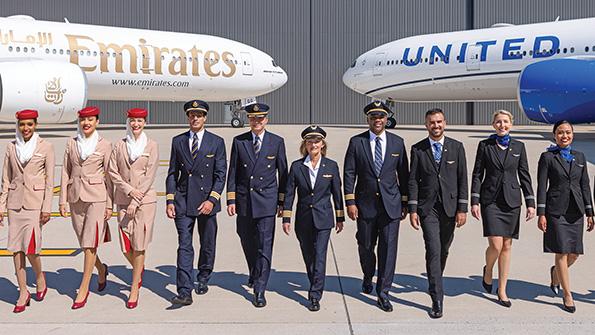
Turn the page back just a few years, and cynicism was creeping in about the value of the global alliances and whether they had grown too big. Beyond that, some questioned the risks of equity partnerships, and there were a few notable intra-alliance spats and splits.
Post-pandemic, all that’s changed, with almost every airline renewing, deepening or beginning a partnership—some of them in surprising places. In mid-January, Qatar Airways announced a new and extensive codeshare with Air Serbia, in which Etihad Airways, a Qatar competitor, has a minority stake.
Another partnership forged over recent months was startling. After years of friction, Emirates Airline and United Airlines began a strategic partnership in 2022 that greatly expands the reach of each carrier, but which at one time would have been unthinkable. Emirates has also entered a codeshare with Air Canada, and some wonder whether Lufthansa—a Star Alliance carrier like Air Canada and United—might be next to shake hands with the Dubai carrier.
A mix of factors coming out of the pandemic seems to be driving this trend for more partnerships. First is the high and fast demand for air travel seen wherever borders reopen and COVID-related restrictions are lifted. Second, also pandemic related, the hiring and training of airline staff to replace those who retired or left the industry have lagged this travel demand surge. Third, aircraft deliveries have slowed because of global manufacturing supply chain issues and, in Boeing’s case, regulatory issues, so new aircraft are not coming as fast as originally scheduled or as airlines would like.
This combination of high demand and resource limitations has made a lot of airlines decide that if they can’t extend their networks as far and as quickly as they would like, partnerships provide a relatively easy and low-cost way to keep growing.
In many ways, a codeshare or even something a bit stronger than that, a partnership, could be described as the cheapest way to extend a network. And if you’re not seeking antitrust immunity, it’s also the fastest route.
Within the US, some strategic partnerships have become key to growth within and well outside America. The American Airlines-Alaska Airlines west coast partnership, for example, means Alaska’s code is now on American’s Los Angeles-Sydney route. Alaska passengers can fly to Australia on one itinerary, which wasn’t possible before. And Alaska didn’t need to buy long-haul widebodies to enhance its offerings to passengers. For American, there is deeper reach into the US Pacific Northwest, particular on smaller routes, without having to put their aircraft into those destinations.
LCCs
LCCs are also playing the partnership game to significantly extend their international networks. WestJet, which has retrenched to its Calgary base with a focus on its traditional western Canada network, has for the first time entered into partnerships with Asian airlines, including Japan Airlines and Korean Air. That has allowed them to place their code on JAL’s Tokyo Narita-Vancouver route and on Korean’s Seoul-Toronto route. In addition, a codeshare agreement with KLM means WestJet can offer Calgary-Amsterdam flights, enabling their customers to connect through one of Europe’s largest gateways. The carrier sees all this network expansion while being able to keep its Boeing 787s on Canadian routes.
Alaska’s joining of oneworld in 2021 was another interesting shift in how airlines are leveraging their global alliance networks. Typically, each of the alliances has included just one airline from a country. Oneworld not only now has American and Alaska as members, but those airlines have the additional bond on their west coast partnership. It’s a case of prioritizing and leveraging mutual network benefits over protecting territories.
On the other side of the US, American has its Northeast Alliance (NEA) with JetBlue Airways. Essentially, the two are operating in partnership from New York and Boston and they can set their schedules accordingly; some 700 daily departures will operate this year as part of the NEA. That alliance, approved by the US Department of Transportation under the previous Trump administration, has been challenged by the current administration, with the Department of Justice taking the airlines to court citing potential anti-competitive behavior. The judge’s decision is expected early this year, but the industry consensus is that the additional legal scrutiny will only highlight the additional competition and benefits the NEA has brought to consumers in a highly important market.
Partnerships, codeshares and alliances are enabling more people to get wherever they want in the world more easily. And airlines are fast realizing that they are a relatively simple but highly effective network growth tool.
Hear ATW, Routes and CAPA editors discuss this topic on the Window Seat podcast





